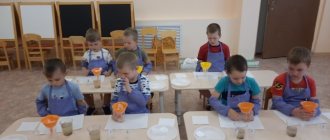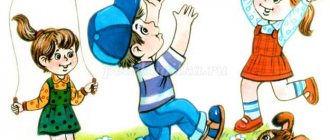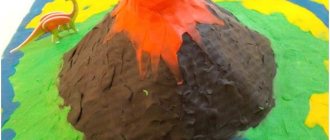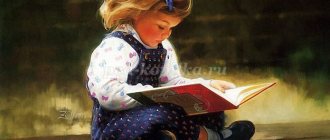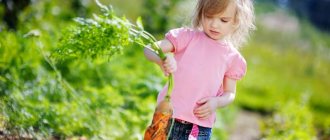Organization of work activities during outings for older children
Publications on the topic:
Formation of positive motivation for work in older children (from work experience) Interest in work, the necessary work skills and personal qualities are established in childhood. The task of teachers and parents is not to miss this.
Master class “Organization of experimental activities for children of senior preschool age” Municipal government preschool educational institution “Kindergarten No. 10” of a combined type in the city of Karabash MASTER CLASS.
Work experience “Organization of experimental activities for children of senior preschool age” “Everything is learned firmly and for a long time when the child hears, sees and does it himself” (R. Emerson). 1. Relevance In the sixth year of life, children reach.
Organization of activities for older children on a walk in the spring. Organization of activities for older children on a walk in the spring. Goal: teach to observe spring nature; develop cognitive.
Organization of play activities during a walk with older preschool children. Using non-main roles, the child tried to regain his former trust. You can often observe how long and enthusiastically children make crafts.
Organization of play activities during a walk with children of senior preschool age A walk occupies a special place in the daily routine of a kindergarten. When organizing a walk, we take into account, first of all, the selection of different types of games.
Organization of outdoor games of varying intensity during walks for preschool children. Outdoor games are of great importance for the comprehensive harmonious development of preschool children. Using game moments while walking.
Organization of productive activities in groups of children of senior preschool age. The concept of “productive activity” includes several types of activity - drawing, designing, modeling, applique - traditionally.
Organization of theatrical activities as a condition for the aesthetic development of children of senior preschool age Organization of theatrical activities as a condition for the aesthetic development of children of senior preschool age Completed by: Egusheva T. N.
Organization of labor activities in the middle group during a walk Municipal autonomous preschool institution, general education kindergarten No. 15, Tuymazy, Tuymazinsky municipal district.
Outline “Work in nature in the senior group”
Tasks:
- Formation of a positive attitude towards nature in children.
- To form knowledge and develop children’s skills in caring for natural objects.
- To instill in children the motive for socially significant work.
- Improve children's labor skills and abilities.
Materials for the lesson: oilcloth, aprons, disposable cups for each child, a stick, a watering can with water, a box or bucket of soil, scoops, jars with cuttings in water for each child, the teacher has several indoor plants (Geranium), from which cuttings are taken .
Move
Introductory conversation with children about indoor plants. • What plants do you know in this corner of nature? (Children name several plants.) • Why are they called indoor plants? (These are plants that in our area do not grow in the open ground all year round, because they do not tolerate cold winters.) Surprise moment: A knock is heard on the door, the postman comes in and brings a beautiful box. The teacher explains that in order to find out what is in the box and open it, you need to guess the riddle: Riddle. Round leaves, Lush flowers, Even very good - That’s what the kids decided. On the window so early... (geranium) blossomed.
Educator: Each flower is beautiful in its own way. Geranium is a symbol of warmth and comfort, a symbol of a home where you are always welcome. It’s not for nothing that geranium is called “grandmother’s flower.” “Granny” means dear, familiar, homely... The flower was born far, far away in South Africa. Travelers and seafarers brought it to us. Everyone liked it because it blooms so beautifully. Let's take a closer look at geranium (pelargonium). This plant is light-loving, it has a straight stem, rounded, light green leaves on long cuttings. Brown, brownish circles seem to be drawn on the leaves. Flowers grow in a “bouquet” - an inflorescence.
Planting a cutting. Educator: Guys, who wants to plant a geranium cutting and then give such a beautiful plant to their mother? (Children speak out.) How to plant cuttings? (Teacher demonstration.)
- Make a hole with a stick, stick it into the ground and scroll.
- Place the cutting in a hole in the ground.
- Press the soil near the cuttings, but not too close to the stem.
- Water the planted cuttings.
Independent work activity. Planting cuttings by children. Children count the number of leaves and remember. When a new leaf appears, the cutting has taken root and is growing. Water the plant.
Outcome of the lesson: Talk with children about caring for plants. Remind them that the children will bring these plants as a gift to their mother.
Socially useful work senior group card index
File of work orders
for children of senior preschool age
compiled by: teacher Marchuk N.A.
EXPLANATORY NOTE
Labor activity in kindergarten
Labor education is one of the most important aspects of raising the younger generation. In kindergarten, labor education consists of familiarizing children with the work of adults and introducing children to the work activities available to them. In the process of introducing adults to the work, the teacher forms in children a positive attitude towards their work, a caring attitude towards its results, and a desire to provide adults with all possible help.
Labor education in the program is a mandatory component of the development of the child’s basic and creative abilities, the most important means of developing a culture of interpersonal relationships.
The task is to gradually develop in children (taking into account age capabilities and gender characteristics) an interest in the work of adults, fostering a desire to work, basic work skills, and hard work.
In accordance with the program, labor education includes the main types: self-service, household work, work in nature, manual labor, and the forms of its organization are assignments, duty, general, joint and collective work of children.
Brief description of types of work:
Self-care is the work of a child aimed at serving himself (dressing, undressing, eating, washing).
Household work - work on cleaning the premises, washing dishes, laundry, etc. Unlike self-service, it has a social orientation. The child learns to create and maintain the environment in an appropriate manner. A child can use his household skills both in self-care and in work for the common benefit.
Work in nature - caring for plants and animals, growing vegetables in the garden, landscaping the area, participating in cleaning the aquarium, etc.
Manual and artistic labor is work aimed at satisfying the aesthetic needs of a person (making handicrafts).
Brief description of forms of labor organization:
Instructions are a request from an adult addressed to a child to perform some kind of work action. The work assignment according to the form of organization can be: individual, subgroup,
General. By duration: short-term, permanent. In terms of content - correspond to the types of work.
Duty is the work of one or more children in the interests of the whole group (in the dining room, in a corner of nature, in preparation for classes).
Common work - involves organizing children in such a way that, with a common goal, each child performs some part of the work independently.
Joint work involves the interaction of children, the dependence of each on the pace and quality of the other’s work. The goal is single (along the chain).
Collective work is a form of labor organization in which children, along with work, also solve moral problems: agree on the division of labor, help each other if necessary, “fear” for the quality of the overall teamwork.
These methodological recommendations were developed to provide methodological assistance to educators in organizing the work activities of preschoolers.
Regular and methodologically correctly organized work on labor education by the end of children’s stay in kindergarten should give the following results:
• preschoolers' interest in work will increase;
• skills of joint activities will be formed;
• a team of children and group self-government will emerge, thanks to cooperation between subgroups;
• children's understanding of the environment will expand;
• a favorable atmosphere will be created for the manifestation of the personality of each child and its development;
• The inclinations, skills, aspirations and activity of each child will be revealed more clearly;
• The importance of the positive influence of the team on the individual will increase; friendships will be strengthened; close friendly contacts, mutual understanding, mutual control, mutual assistance, mutual education will be established; cooperation and support will become the norm;
• A sense of public duty will be formed;
• Work will become a necessity for children.
File of work orders
for children of senior preschool age
Task No. 1
"Watering indoor plants."
Goal: to expand children’s knowledge about the needs of plants for light and moisture, to teach how to recognize moisture-loving and drought-resistant, light-loving and shade-tolerant plants by their leaves. Develop accuracy when working with water and plants, confidence in your actions, work skills. Foster a caring attitude towards the natural environment and a desire to take care of it.
Task No. 2
"Washing houseplants."
Goal: to give children an idea of the methods of watering (in a tray, under the leaves) and the rules (do not flood, water evenly); cultivate a desire to care for plants. Invite children to help as much as possible, clarify children’s ideas about indoor plants.
Task No. 3
“Spraying indoor plants with water from a spray bottle.”
Goal: teach a new work skill; reinforce children’s understanding that leaves also need moisture; cultivate a caring attitude towards plants. Teach children to independently determine the need for watering (by the color and condition of the soil, by the appearance of the plant), and remind them of the watering technique.
Task No. 4
“Green landing on indoor plants”
(remove diseased leaves, fertilize).
Goal: to teach children to determine by the condition of indoor plants what actions are necessary to care for them (watering, cleaning, loosening, fertilizing), to correctly perform the corresponding labor operations, and invite the children to tell about the purpose of each of them.
Task No. 5
"Taking care of plants."
Goal: to clarify previously acquired knowledge about ways to keep plants clean, to teach children how to choose a method for removing dust from a plant, focusing on the features of its appearance and structure.
Task No. 6
"Loosening the soil of indoor plants."
Goal: teach children to care for indoor plants; give children knowledge about why it is necessary to loosen the soil of plants; consolidate loosening techniques and rules for using the necessary items for this. Develop labor skills, accuracy. Foster an ecological culture and respect for the environment.
Task No. 7
"Feeding plants."
Goal: to tell children about the need to feed plants, based on children’s knowledge that the source of nutrition for plants is the soil, and that gradually, by giving up nutrients to plants, the soil is depleted. Show how to fertilize plants.
Task No. 8
"Washing pallets."
Goal: to teach children to do work independently and responsibly, distribute responsibilities, and coordinate actions.
Task No. 9
"Transplanting indoor plants."
Goal: to expand children’s understanding of the labor involved in caring for plants of various types: to learn how to replant indoor plants. Introduce children to the sequence and technique of work, the rules of personal hygiene, and offer to provide all possible assistance to the teacher.
Task No. 10
"Planting onions."
Goal: to teach children to set a goal, prepare a workplace, tools and clean up after themselves. To consolidate children's knowledge about the structure of the onion and the conditions necessary for onion growth. Develop labor skills and habits, accuracy when working with land, water and plants. Foster an environmental culture, a desire to achieve results, and participate in a common cause.
